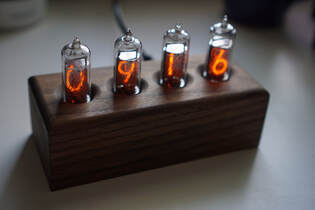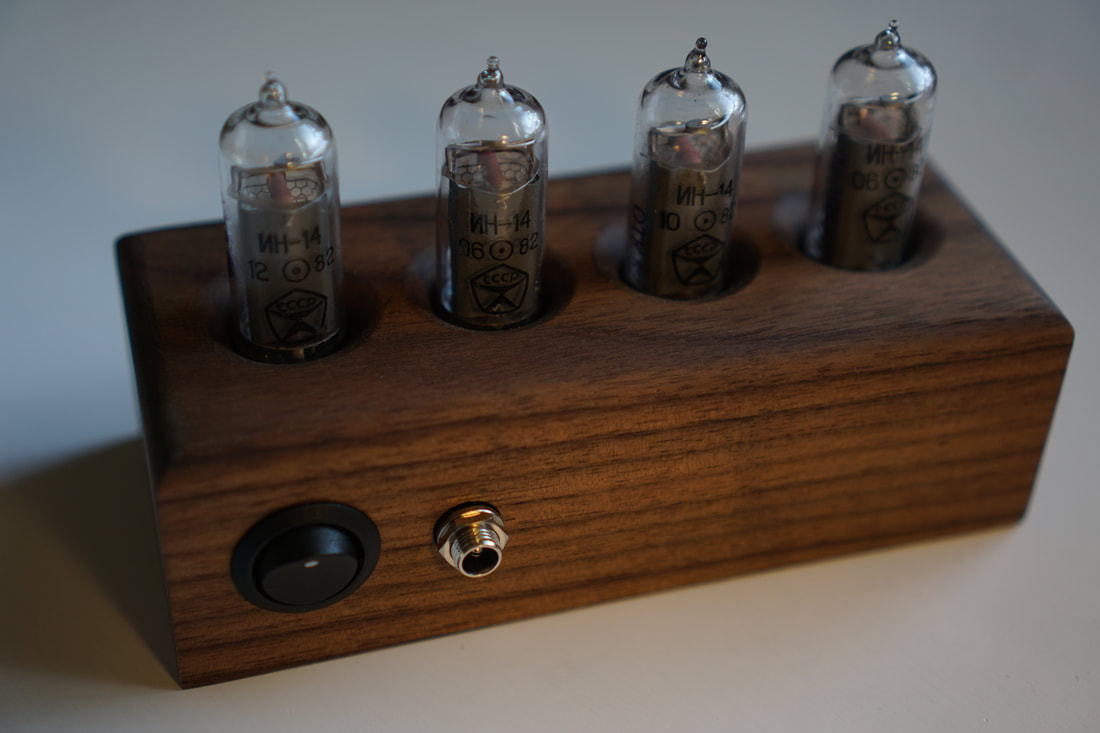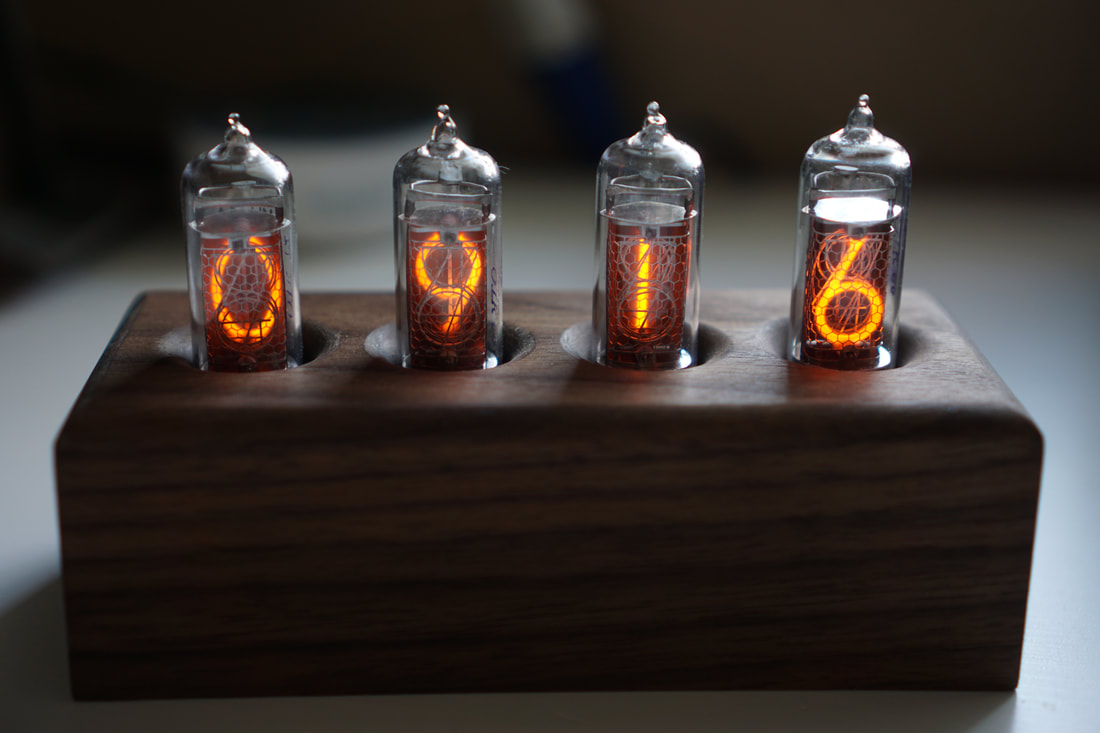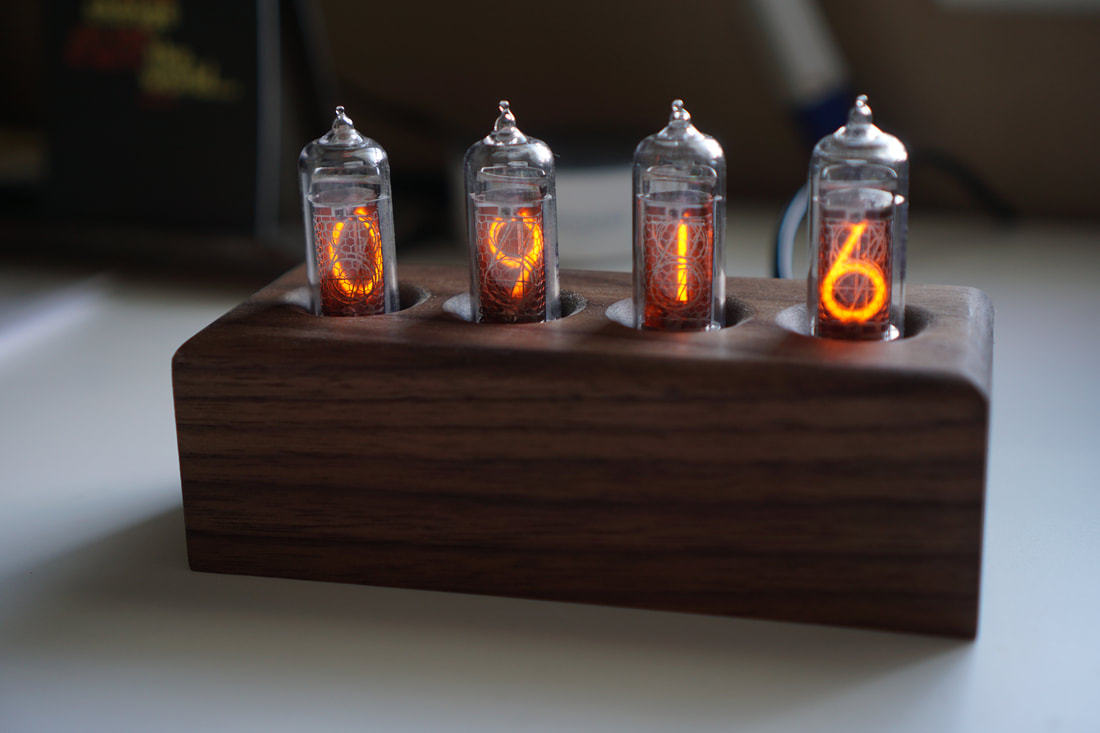Nixie Clock
Yes, yet another nixie clock in the world

Nixie tubes are a type of high-voltage, cold cathode numerical display used in the mid-1950s. In the 2010s, they made a resurgence due to their warm, glowing aesthetic and steampunk-y look. Even as they were replaced in the 70s by cheaper, simpler LCD and LED technology, suppliers in the Soviet Union continued to produce, resulting in a trove of "new old stock" hitting eBay for fairly cheap (few dollars per tube) in recent years.
I loved the retro-cool vibe of Nixies and so built a clock of my own. I user IN-14 type tubes manufactured in Soviet Union probably in late '70s/early '80s. The tubes are common anode (the wire mesh grid at the front of the tube) with a firing voltage of 170V. Each cathode is connected to one of the number plates; there are also two small decimal plates to the lower left and right of each digit. I used power 8-bit shift registers (six Texas Instruments TPIC6B595DWR) to sink the cathodes. These registers have 50V zener clamps on each of the open-drain outputs so the internal FETs are protected from the cathode voltages. The leakage current through the outputs when off is low enough to prevent the "off" Nixie plates from glowing. The high voltage supply is generated by a small board I got off eBay from a 12V DC barrel jack supply. For the "brains," I used a Raspberry Pi Zero W. The C code grabs the time from the internet, translates it into a bit array, and then shifts out to the registers. A hex inverter (SN74HCT04DR) is used for logic-level conversion. Because it was a quick board, I tried out EasyEDA for the first time; I was impressed for an in-browser ECAD. Quick-turn PCB from JLPCB. It's amazing how fast and cheap boards are these days. Five boards for $10 shipped.
While a Raspberry Pi might be overkill for the timekeeper of a clock, grabbing the local time from the internet rather than a timer IC or RTC meant I would never have to set the clock ever again. The datetime displayed would always be accurate, regardless of daylight savings or region. It wouldn't run fast or slow. I could unplug the device for days and plug it in, give it a few seconds and it'll auto-update the display to the accurate time. It also allows for easy extension to support other functions, like showing flashing the high and low temp for the day or the time of my first meeting.
The case is made from a single piece of walnut finished with dutch oil. I originally sketched up a more complex design, but decided to pare back the case to make the Nixies stand out. Round overs and counter sinks were made with a 1/2 inch router. The case only has a DC barrel jack and power switch on the rear.
I loved the retro-cool vibe of Nixies and so built a clock of my own. I user IN-14 type tubes manufactured in Soviet Union probably in late '70s/early '80s. The tubes are common anode (the wire mesh grid at the front of the tube) with a firing voltage of 170V. Each cathode is connected to one of the number plates; there are also two small decimal plates to the lower left and right of each digit. I used power 8-bit shift registers (six Texas Instruments TPIC6B595DWR) to sink the cathodes. These registers have 50V zener clamps on each of the open-drain outputs so the internal FETs are protected from the cathode voltages. The leakage current through the outputs when off is low enough to prevent the "off" Nixie plates from glowing. The high voltage supply is generated by a small board I got off eBay from a 12V DC barrel jack supply. For the "brains," I used a Raspberry Pi Zero W. The C code grabs the time from the internet, translates it into a bit array, and then shifts out to the registers. A hex inverter (SN74HCT04DR) is used for logic-level conversion. Because it was a quick board, I tried out EasyEDA for the first time; I was impressed for an in-browser ECAD. Quick-turn PCB from JLPCB. It's amazing how fast and cheap boards are these days. Five boards for $10 shipped.
While a Raspberry Pi might be overkill for the timekeeper of a clock, grabbing the local time from the internet rather than a timer IC or RTC meant I would never have to set the clock ever again. The datetime displayed would always be accurate, regardless of daylight savings or region. It wouldn't run fast or slow. I could unplug the device for days and plug it in, give it a few seconds and it'll auto-update the display to the accurate time. It also allows for easy extension to support other functions, like showing flashing the high and low temp for the day or the time of my first meeting.
The case is made from a single piece of walnut finished with dutch oil. I originally sketched up a more complex design, but decided to pare back the case to make the Nixies stand out. Round overs and counter sinks were made with a 1/2 inch router. The case only has a DC barrel jack and power switch on the rear.
© Ishan Chatterjee 2020




